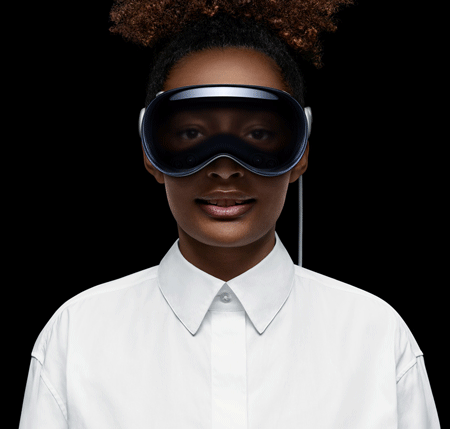Apple’s Vision Pro: What will it take to go big?
The newest product from the world’s most valuable company will transform the world, but not for quite some time.
By Brad Berens
 I’ve been hesitant to write about Apple’s new “spatial computing” device: the thing that the world’s most valuable company doesn’t want to call an Augmented Reality (AR) headset. However, since there are things that I haven’t seen others talk about, here goes…
I’ve been hesitant to write about Apple’s new “spatial computing” device: the thing that the world’s most valuable company doesn’t want to call an Augmented Reality (AR) headset. However, since there are things that I haven’t seen others talk about, here goes…
Who is the real competition?
It’s a distraction to compare the Vision Pro to the Meta/Oculus Rift, Microsoft’s HoloLens, HTC’s Vive, or any of the other Heads Up Display (HUD) rigs, whether those devices are fully immersive Virtual Reality (VR) or two-worlds AR (or MR, XR, or any of the other spoonfuls of alphabet soup).
The Vision Pro isn’t competing with other HUD: it’s competing with all the other hardware in your life:
- Smartphone
- Laptop/Desktop
- Television
- Stereo System
- Game Console
If you add up the costs of those five appliances, then suddenly $3,500 for the Vision Pro doesn’t cause the same level of sticker shock.
Watch Apple’s nine-minute film about the Vision Pro and pay attention to the sparse nature of the living rooms portrayed. You’ll spot a few Mac laptops, but no big screen on the living room wall, no X-Box, and no speakers.
In the same way that the smartphone turned your calendar, to do list, camera, kitchen timer, notebook, flashlight, calculator, car keys, map, watch, and MP3 player into apps, the Vision Pro aims to reduce independent big pieces of hardware to features on the headset.
In the same way that most young people setting up a first apartment today don’t get landlines and don’t subscribe to cable television (preferring smartphones and streaming), in a few years their younger siblings won’t buy big monitors, game consoles, and personal computers.
Today, in 2023, Vision Pro won’t replace your phone and probably won’t replace your laptop/desktop, but that’s where the technology is heading.
That journey will take a long time.
Newton : iPhone :: Vision Pro : Apple Glasses
Remember the Newton? It was Apple’s first handheld device, a Personal Digital Assistant released in 1993—14 years before the first-generation iPhone came out in 2007. The first Newton cost $900 (that would be $1800 today according to Ars Technica.) Like the Vision Pro today, the Newton was expensive compared to other such devices (the first Palm Pilot in 1996 cost $299).
The Newton comparison is handy because it sets up a clear arc for the Vision Pro.
With the Newton, Apple broke new conceptual ground with a product that only wealthy people could afford. Apple used those wealthy people as beta-testers for a new concept of handheld computing. That concept evolved over 14 years, and then it transformed into the iPhone, history’s most successful consumer electronics product.
The first iPhone cost $599 in 2007: still pricey, but cheaper than the Newton 14 years earlier.
Roughly speaking, Moore’s Law says that the number of transistors on a microchip doubles every two years while the price is cut in half every two years. Depending on how you count, that means that between the Newton and the iPhone the technology was 64x more powerful and 1/64th the cost to the manufacturer.*
In the same way that the smartphone turned your calendar, to do list, camera, kitchen timer, notebook, flashlight, calculator, car keys, map, watch, and MP3 player into apps, the Vision Pro aims to reduce independent big pieces of hardware to features on the headset.
Customers will get the Vision Pro sometime next year. Following the Newton arc, we’ll see the first mass-market, explosively successful HUD device deep into the 2030s (let’s say 2038). It won’t be called “Vision Pro.” Instead, I suspect it will simply be called Apple Glasses.
Apple Glasses will:
- Cost $2,400 (about $800 in 2023 buying power)
- Weigh less than a quarter pound
- Look like a conventional pair of spectacles
- Have insertable prescription lenses
- Not have the weird projected eyes of the Vision Pro
- Sport a typical battery life of 8+ hours
- Replace the appliances that I listed earlier, except for the smart phone.
- Transform our relationship to information, media, entertainment, and communications as profoundly as the smartphone did.
While today, Apple imagines the Vision Pro as a mostly in-the-home device, by 2038 Apple Glasses will be ready for city streets and the great outdoors.
Even with 14 years of technological advancement to count on, there are still some important caveats. Apple Glasses wearers will have a wire that runs down the back of the neck to a battery about the size of an iPhone Pro Max today. In fact, that battery might be a smartphone, albeit one with fewer bells and whistles than today’s, which would allow Apple to offload a big chunk of the Glasses’ computational work off the face and into the pocket.
Recently, in “Adventures in Self-Disruption,” I wrote about Apple’s unusual history in cannibalizing its own successful products (like how the iPhone ate the iPod), so I won’t reiterate that here.
Apple co-founder Steve Jobs allegedly once quipped, “If you really look closely, most overnight successes took a long time.”
Apple has the money to invest and can take the time to get HUD right.
__________

Brad Berens is the Center’s strategic advisor and a senior research fellow. He is principal at Big Digital Idea Consulting. You can learn more about Brad at www.bradberens.com, follow him on Post and/or LinkedIn, and subscribe to his weekly newsletter (only some of his columns are syndicated here).
* Here’s how I counted: 1x2x2x2x2x2x2 = 64. From Year One (Y1) to Y2 is the double from 1 to 2. Then, for the following six years it’s two to the sixth power, which is 64.
See all columns from the Center.
June 29, 2023

